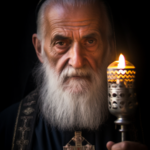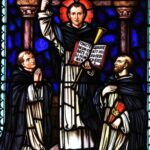St. William of Montevergine
St. William of Montevergine
When they lived:
St. William of Montevergine, also known as Saint William of Vercelli, lived during the 11th and 12th centuries. He was born in the year 1085 and died on June 25, 1142.
Where they lived:
St. William of Montevergine spent most of his life in Italy. He was born in Vercelli, a city in the Piedmont region of northern Italy. He later founded the Monastery of Montevergine in the Campania region, which is in southern Italy. This monastery became a significant center of religious life during his time.
Notable world events during the time of their life:
- First Crusade (1096-1099): St. William’s early years coincided with the First Crusade, a major military campaign in which European Christians sought to recapture Jerusalem from Muslim control. This event had significant repercussions for Christianity and the entire Mediterranean world.
- Investiture Controversy (1075-1122): The Investiture Controversy was a power struggle between the papacy and European monarchs over the appointment of bishops and abbots. It had profound implications for the relationship between the Church and secular authorities, influencing the political and religious landscape of St. William’s time.
- Scholasticism Emerges (12th century): The 12th century saw the emergence of Scholasticism, a philosophical and theological movement that sought to reconcile faith and reason. Figures like St. Anselm and Peter Abelard played significant roles in this intellectual movement, which contributed to the development of Catholic theology.
- Birth of Genghis Khan (1162): Although St. William of Montevergine did not live to see this event, his lifetime overlapped with the birth of Genghis Khan, the founder of the Mongol Empire. This event marked the beginning of a significant chapter in world history, with far-reaching consequences.
Patronage:
St. William of Montevergine is venerated as the patron saint of various groups and causes:
- Patron Saint of Montevergine: He is the primary patron of the Monastery of Montevergine and the surrounding region. Pilgrims visit his shrine at the Montevergine Sanctuary to seek his intercession.
- Childless Couples: St. William is invoked by couples who are struggling with infertility or are seeking to have children. His intercession is believed to bring blessings to those desiring to start a family.
- People in Need of Mental Healing: Due to his own struggles with mental health, St. William is also considered a patron saint for those dealing with mental illness or seeking mental and emotional healing.
- Monastic Life: As the founder of the Montevergine Monastery, he is a patron saint of monks and the monastic way of life. His dedication to a life of prayer and contemplation serves as an inspiration to those in religious communities.
- Protection Against Earthquakes: In regions prone to earthquakes, St. William is invoked for protection against these natural disasters.
St. William of Montevergine’s life, marked by his dedication to spirituality and his ability to overcome personal challenges, continues to inspire people across different walks of life and serves as a reminder of the enduring power of faith and perseverance.
The Life and Works of William of Montevergine
Born of noble parents, William of Montevergine lost his parents at a very young age. As a result of this, a family member raised him. When he reached a suitable age, he undertook a pilgrimage to Santiago de Compostela.
While on this pilgrimage, he came across a blacksmith. He instructed the blacksmith to make an iron implement. This iron implement was to encircle his body, causing pain to William of Montevergine. Hesitantly, the blacksmith made the iron implement. With this implement, William of Montevergine continued his pilgrimage.
Upon returning to Italy, he was beaten up and robbed by thieves. He had intended to continue his pilgrimage to Jerusalem. However, once the thieves beat him up, it was taken as a sign by God to remain in Italy and spread the word of Christ instead.
With this sign of God to remain in Italy, William of Montevergine settled on the summit of Mount Vergine. Here, he lived as a hermit and spread the word of Christ. Soon after this, he gained several followers and founded the Monastery of Montevergine.
Roger II of Sicily served as William’s patron. He also built and founded several monasteries around Sicily in order to continue spreading the word of Christ and helping women and men who needed it. When he became patron to William, he built a monastery opposite his palace. This was done to ensure that William always remained near him. It is also said by Roger II that William was able to perform miracles.
One of his most notable miracles that he performed is known as the “Miracle of the Wolf.” This miracle was performed in 1591. One day at the monastery in Montevergine, a wolf killed a donkey. At the monastery, donkeys are seen as saints and are very valuable. They are used for towing and other tasks around the grounds of the monastery. Upset by the killing of the donkey, William of Montevergine ordered the wolf to perform the tasks of the slain donkey. The donkey immediately became tame and docile, performing all the tasks of the donkey he had slain. The people at the monastery were shocked to see this happen but praised William for his actions.
One of the duties of a priest is to exercise their ministry and continue to spread the word of Christ. Being a hermit, this compromised his chosen way of living. His way of life was also not agreed upon by his fellow priests in the area, who said that his chosen way of life was too private and strict.
As a result of these disagreements with his way of life, William of Montevergine decided to leave Montevergine. In 1128, he left and settled on the plains in Goleto. Here, he founded several monasteries and began to experience a new way of monastic life. He lived in a double monastery, built mostly by the women in the area.
While living and experiencing this new way of monastic life, William of Montevergine also undertook several trips to Apulia. Here, he continued to spread the word of Christ.
The Death of William of Montevergine
On June 25, 1142, William of Montevergine passed away in Goleto of natural causes. His remains stayed in Goleto. On September 2, 1807, the king of Naples, Gioacchino Murat, ordered the remains of William of Montevergine to be transported back to Montevergine.
In 1224, William of Montevergine was canonized by Pope Pius XII and became the patron saint of Irpinia. He is venerated in the Roman Catholic Church, often being attributed to having a wolf and crosier by his side.
5 Interesting Facts About St. William of Montevergine
- In Italian, William of Montevergine is known as Gulielmo.
- The miracle performed by William at Ouse Bridge is believed to
have led to him being canonized. - He undertook his first pilgrimage at the young age of fourteen.
- He is known for being barefoot and choosing not to wear shoes.
- His relics can still be seen in Montevergine today.
Prayer to St. William of Montevergine
St. William of Vercelli, You were a father to your monks and a shepherd to your people. Pray for us that we might have our sight restored and that we might see, with the eyes of our hearts and souls,God’s presence in and around us. Teach us to nourish our spiritual journeys with prayers so that we too might be instruments of God’s light and love to others. In the spirit of St. Benedict, help us to be people of hospitality who let our work become prayer. Let us find God in each other. Amen.



